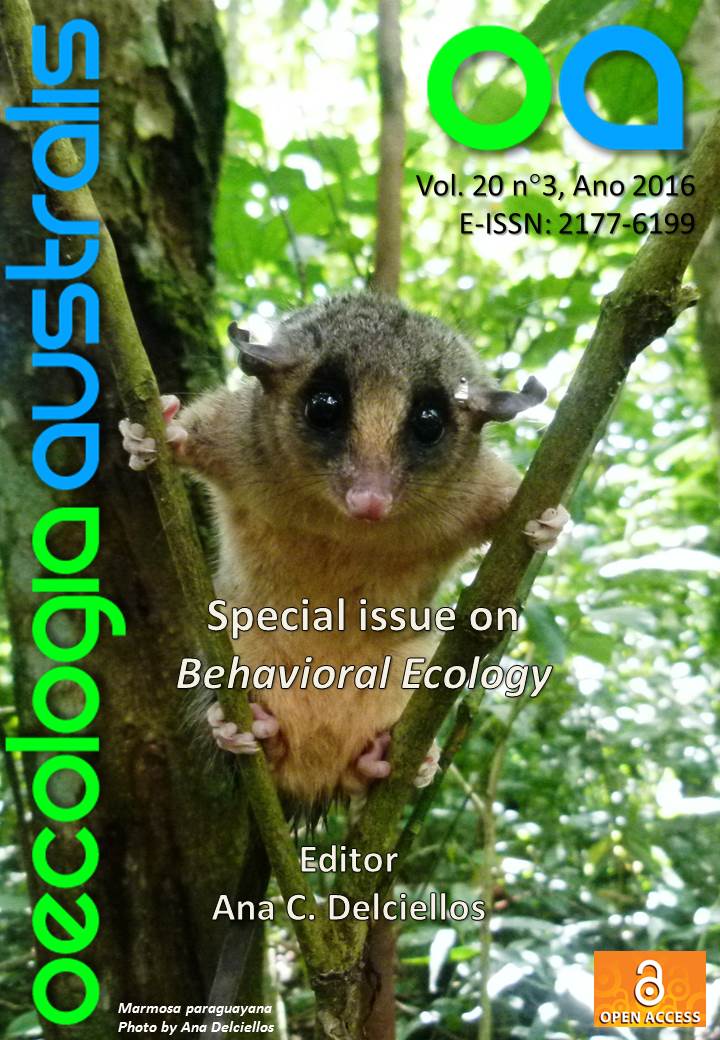POSTURAL CLIMBING BEHAVIOUR OF DIDELPHID MARSUPIALS: PARALLELS WITH PRIMATES
DOI:
https://doi.org/10.4257/oeco.2016.2003.07Keywords:
Climbing ability, Gait, Locomotion, Opossums, Zygodactylous graspAbstract
Differences in body size and in the use of arboreal strata limit the climbing behaviour and performance of didelphids. Similarly to primates, the arboreal canopy dweller, Caluromys philander exhibits a diagonal-sequence gait. In contrast, terrestrial didelphids use a symmetrical lateral sequence in horizontal locomotion. Postural behaviour along thin supports may allow understanding the mechanisms behind the higher performance of arboreal didelphids climbing. Here in, we describe and compare gait sequence and postural behaviour of seven didelphids climbing a slender and flexible vertical support. Animals were stimulated to climb a vertical support of 1.25 cm diameter. Postural behaviour was qualitatively described for each species in the cycle of maximum velocity by a frame-by-frame analysis of gait cycles, evaluating (1) movements of the tail, (2) posture of hand and wrist when grasping, (3) distance of the body to the support, (4) lateral swinging of the body, (5) orientation of the head, (6) limb posture, and (7) stride cycle. Only arboreal species were capable of climbing with only two limbs grasping the support, keeping a straight body orientation at some distance from the support, and sustaining a more constant and regular climbing velocity. The tail played a role in didelphids with better climbing performance (i.e., higher relative velocity), counteracting the lateral swinging of the body, helping with the animal balance. However, the prehensile ability of the tail was not used in climbing. The most stunning result is that all didelphids grasped the rope between digits 2-3, a schizaxonic grasp, involving a neutral hand orientation regarding the ulna. The didelphids protracted the humerus at forelimb touchdown, and the angle between the arm and the horizontal body axis was greater than 90°. The same postures were already observed in horizontal locomotion of C. philander, Monodelphis domestica, and primates. Locomotory and postural adaptations for an arboreal lifestyle in didelphids seem to be limited to small to medium body sizes, up to the size of species of Caluromys. The arboreal locomotion of didelphids is an important key to understand adaptation and evolution of mammals to an arboreal niche, and the comparison with small primates may help to identify adaptive convergence to arboreal locomotion.Downloads
Download data is not yet available.
Downloads
Additional Files
- camiladebarros, Cover Letter - Antunes et al (1).pdf (Português (Brasil))
- camiladebarros, Figure 1 - Antunes et al.tif (Português (Brasil))
- camiladebarros, Figure 2 - Antunes et al.tif (Português (Brasil))
- camiladebarros, Figure 3 - Antunes et al.tif (Português (Brasil))
- camiladebarros, Figure 4 - Antunes et al.tif (Português (Brasil))
- camiladebarros, Figure 5 - Antunes et al.tif (Português (Brasil))
- camiladebarros, Figure 6 - Antunes et al.tif (Português (Brasil))
- camiladebarros, Figure 7 - Antunes et al.tif (Português (Brasil))
- camiladebarros, Figure 8 - Antunes et al.jpg (Português (Brasil))
Published
2017-02-24
Issue
Section
Articles


